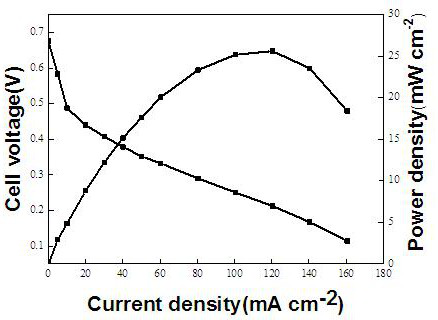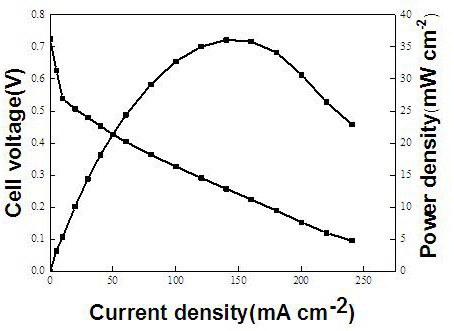Direct methanol fuel cell catalyst layer gradient membrane electrode and preparation method thereof
A methanol fuel cell and catalytic layer technology, applied in fuel cells, battery electrodes, electrochemical generators, etc., can solve problems such as hindering heat dissipation, fuel and gas transmission, non-uniform distribution of current density, battery aging, etc., to improve concentration The effect of uneven distribution, high water and heat management capacity, and improved utilization
- Summary
- Abstract
- Description
- Claims
- Application Information
AI Technical Summary
Problems solved by technology
Method used
Image
Examples
Embodiment 1
[0041] According to the above steps, the gradient electrode and the membrane electrode of the catalytic layer of the direct methanol fuel cell were prepared, and the discharge test was carried out. The main steps are as follows:
[0042] (1) Preparation of electrodes
[0043] Carbon paper containing polytetrafluoroethylene (PTFE) is used as a diffusion layer, and a microporous layer containing PTFE is coated on the hydrophobic diffusion layer, wherein the content of polytetrafluoroethylene is 15wt.%. Prepare the appropriate proportion of catalyst slurry, using isopropanol as solvent. Use PtRu / C as a catalyst on the anode side and Pt / C as a catalyst on the cathode side, and spray coating on the microporous layer in gradient to form a catalyst layer.
[0044] (2) Treatment of proton exchange membrane
[0045] The membrane was exposed to 5wt.% H 2 o 2 Boil in solution for 1 hour, then wash in deionized water, then boil in 0.5M sulfuric acid solution for 1 hour, and finally boi...
Embodiment 2
[0053] The direct methanol fuel cell catalytic layer graded membrane electrode of the present invention is tested under the condition of high temperature and dry oxygen. Firstly, a gradient electrode with catalytic layer was prepared according to the same procedure as in Example 1, and a single cell was assembled for discharge test.
[0054] The test conditions are: battery operating temperature 60°C, normal pressure, anode fuel is 1M methanol (flow 2ml min-1), cathode air intake is dry oxygen (flow 199ml min -1 ). The limiting current density can reach 240.32mA cm -2 , the maximum power density reaches 36.10mW cm -2 , Example 2 increased by 37.84% compared to Comparative Example 2.
PUM
 Login to View More
Login to View More Abstract
Description
Claims
Application Information
 Login to View More
Login to View More - R&D
- Intellectual Property
- Life Sciences
- Materials
- Tech Scout
- Unparalleled Data Quality
- Higher Quality Content
- 60% Fewer Hallucinations
Browse by: Latest US Patents, China's latest patents, Technical Efficacy Thesaurus, Application Domain, Technology Topic, Popular Technical Reports.
© 2025 PatSnap. All rights reserved.Legal|Privacy policy|Modern Slavery Act Transparency Statement|Sitemap|About US| Contact US: help@patsnap.com



